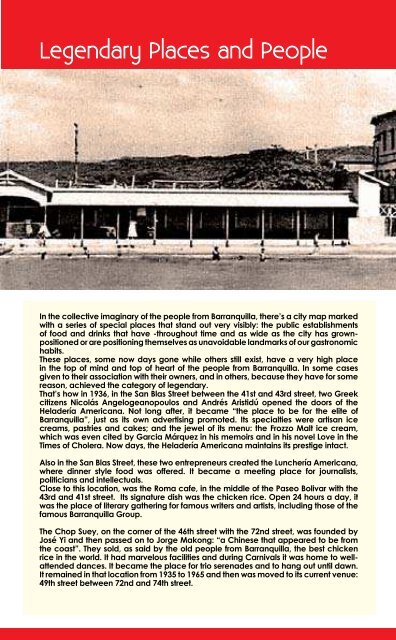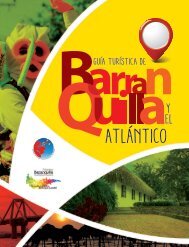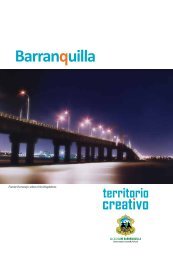Untitled - Barranquilla Capital Americana de la Cultura 2013
Untitled - Barranquilla Capital Americana de la Cultura 2013
Untitled - Barranquilla Capital Americana de la Cultura 2013
You also want an ePaper? Increase the reach of your titles
YUMPU automatically turns print PDFs into web optimized ePapers that Google loves.
Legendary P<strong>la</strong>ces and People<br />
In the collective imaginary of the people from <strong>Barranquil<strong>la</strong></strong>, there’s a city map marked<br />
with a series of special p<strong>la</strong>ces that stand out very visibly: the public establishments<br />
of food and drinks that have -throughout time and as wi<strong>de</strong> as the city has grown-<br />
positioned or are positioning themselves as unavoidable <strong>la</strong>ndmarks of our gastronomic<br />
habits.<br />
These p<strong>la</strong>ces, some now days gone while others still exist, have a very high p<strong>la</strong>ce<br />
in the top of mind and top of heart of the people from <strong>Barranquil<strong>la</strong></strong>. In some cases<br />
given to their association with their owners, and in others, because they have for some<br />
reason, achieved the category of legendary.<br />
That’s how in 1936, in the San B<strong>la</strong>s Street between the 41st and 43rd street, two Greek<br />
citizens Nicolás Angelogeanopoulos and Andrés Aristidú opened the doors of the<br />
He<strong>la</strong><strong>de</strong>ría <strong>Americana</strong>. Not long after, it became “the p<strong>la</strong>ce to be for the elite of<br />
<strong>Barranquil<strong>la</strong></strong>”, just as its own advertising promoted. Its specialties were artisan ice<br />
creams, pastries and cakes; and the jewel of its menu: the Frozzo Malt ice cream,<br />
which was even cited by Garcia Márquez in his memoirs and in his novel Love in the<br />
Times of Cholera. Now days, the He<strong>la</strong><strong>de</strong>ría <strong>Americana</strong> maintains its prestige intact.<br />
Also in the San B<strong>la</strong>s Street, these two entrepreneurs created the Lunchería <strong>Americana</strong>,<br />
where dinner style food was offered. It became a meeting p<strong>la</strong>ce for journalists,<br />
politicians and intellectuals.<br />
Close to this location, was the Roma cafe, in the middle of the Paseo Bolivar with the<br />
43rd and 41st street. Its signature dish was the chicken rice. Open 24 hours a day, it<br />
was the p<strong>la</strong>ce of literary gathering for famous writers and artists, including those of the<br />
famous <strong>Barranquil<strong>la</strong></strong> Group.<br />
The Chop Suey, on the corner of the 46th street with the 72nd street, was foun<strong>de</strong>d by<br />
José Yi and then passed on to Jorge Makong: “a Chinese that appeared to be from<br />
the coast”. They sold, as said by the old people from <strong>Barranquil<strong>la</strong></strong>, the best chicken<br />
rice in the world. It had marvelous facilities and during Carnivals it was home to wel<strong>la</strong>tten<strong>de</strong>d<br />
dances. It became the p<strong>la</strong>ce for trio serena<strong>de</strong>s and to hang out until dawn.<br />
It remained in that location from 1935 to 1965 and then was moved to its current venue:<br />
49th street between 72nd and 74th street.<br />
Hotel Esperia<br />
Across from the 72nd street, between this one and 74th street, in the 46th street was<br />
the Chow Mein, which belonged to Chinese Alberto Ow. Its signature dish: the special<br />
chow fan. Also in the 72nd street, but in the northeastern corner of the 43rd street was<br />
El Deportivo, an elegant restaurant which offered international gourmet cuisine. And<br />
in the very same 72nd street, between the 47th and 48th street exited for many years,<br />
approximately since the beginning of the 1960’s El Mediterraneo. It belonged to the<br />
Greek Tarchopulos and Si<strong>de</strong>ris families and had a big salon and a splendid terrace,<br />
where well known literary gatherings amongst journalists and politicians took p<strong>la</strong>ce.<br />
In the Chiquinquirá neighborhood, La Casa <strong>de</strong>l Recuerdo, specialized in pork<br />
scratchings, was the temple of the famous Negro Adán (Adán Moreno Sa<strong>la</strong>regui),<br />
a charismatic and p<strong>la</strong>yful character, mentioned by García Márquez in his novel<br />
Autumn of the Patriarch.<br />
In the Gar<strong>de</strong>n City neighborhood, on the 42nd street with 79th street, the Peñita p<strong>la</strong>ce<br />
was famous during the second half of the XXth century, a p<strong>la</strong>ce that counted with a<br />
numerous clientele that inclu<strong>de</strong>d distinguished personalities of the city. It was very<br />
well known and loved because of its pork scratchings, pork chops, egg arepas, bean<br />
fritters, carimaño<strong>la</strong>s and other types of fried fruits of the Caribbean Coast.<br />
In the corner of the 62nd street with 44th street, can be found, since almost over half a<br />
century ago, La Tien<strong>de</strong>cita, the p<strong>la</strong>ce where writer Álvaro Cepeda Samudio prepared<br />
“on occasions his famous hen, tail and rib stew” according to Heriberto Fiorillo’s book<br />
La Cueva, Chronicles of the <strong>Barranquil<strong>la</strong></strong> Group.<br />
The Mi Vaquita restauant, in the 46th street between the 70th and the 72nd street, was<br />
a huge patio with straw huts where birthdays and company parties were celebrated.<br />
Its owner was Pepe Bejman. Also in the northern part of the city, in the Veinte <strong>de</strong> Julio<br />
Avenue was the equally famous Spanish bar La Sil<strong>la</strong> Coja, where food and wines from<br />
the home<strong>la</strong>nd were offered and where Spanish artists frequently performed.<br />
On the outer part of <strong>Barranquil<strong>la</strong></strong>, there are two unforgettable p<strong>la</strong>ces that must be<br />
named. The first is the Pradomar Hotel, which was the country venue of the Hotel<br />
El Prado, and whose restaurant remained at its full capacity during the weekends.<br />
The other is the Esperia Hotel, a property of a German citizen, whose sea terrace ( a<br />
concrete p<strong>la</strong>tform built in the sea and who one could only reach through a gangway)<br />
was very famous and sought after between 1940 and 1950.




